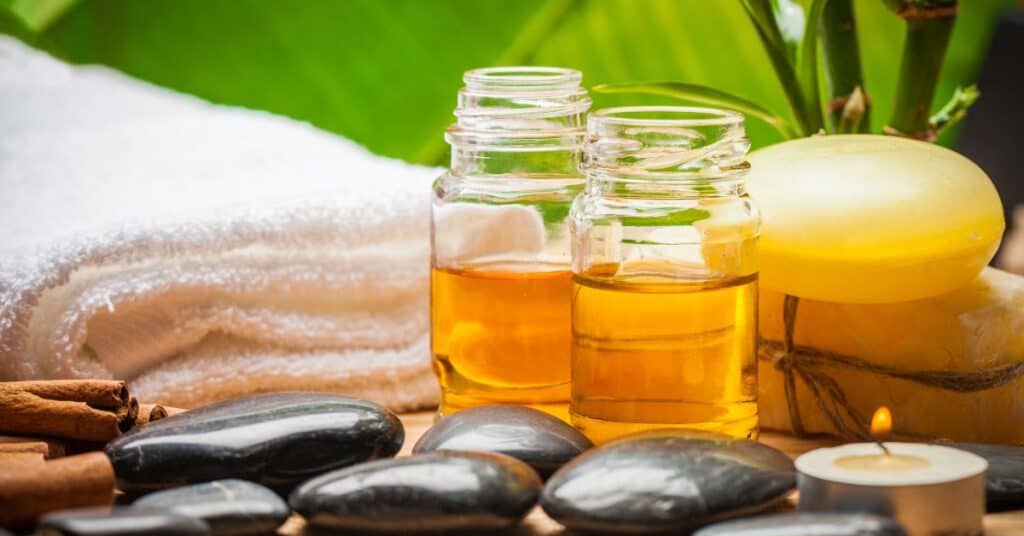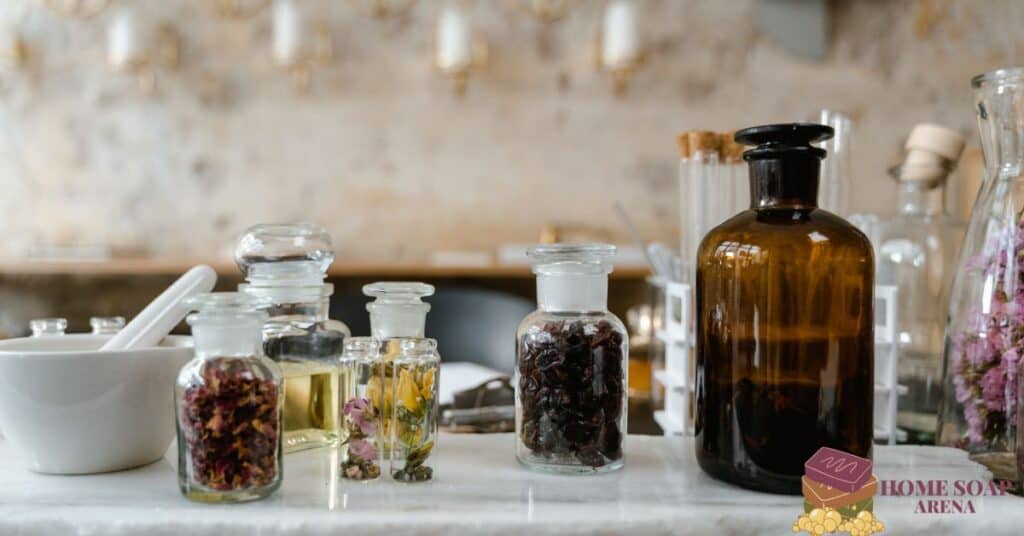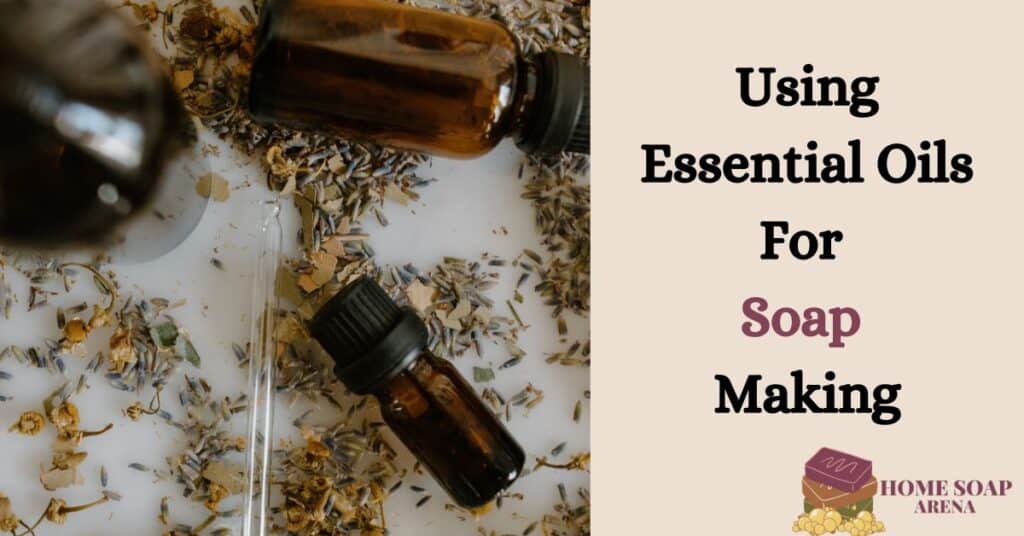Table of Contents
- What Type Of Oil Is Best For Soap?
- Can I Add Oil To The Soap Base?
- What Oil Makes Soap Last Longer?
- What Oil Makes Soap Creamier?
- How Do You Thicken The Soap Base?
- Final Thought
Would you want to know about oil for the soap base? I understand that base oils are used to make lotions, soaps, and other beauty products.
Sticky fats are the best kind of base oil for soap. They make it more challenging and last longer.
Most of the time, solid oils like Coconut oil, Cocoa Butter, and Palm Oil need to be warmed before they can be used. What makes soap lather.
After that, fatty fats can be added to the soap because of their usefulness. Not only that, though. Keep reading, and I’ll teach you more about the best oil for soap base and how to find it.
Now, let’s get started.
What Type Of Oil Is Best For Soap?
It’s easy to make bar soap with coconut, olive, or palm oil. Castor oil is excellent for dry or sensitive skin and makes a great liquid soap.
To produce liquid soap, you can also use jojoba or almond oil. You can also make bar soap with avocado oil. This oil is thick, moisturizing, and creates a creamy lather.
You can make many different kinds of soap by changing your oils. Making your soap is fun and satisfying.
Before making your soap, you should learn about the different types of fats and what they can do for you. This is something I love to use:
1. Olive oil: One of my favorite oils for making soap is olive oil. It’s not expensive and gives the soap a “conditioning” feel. That makes it an excellent oil for soaps for your face and body.
On the other hand, soaps made from olive oil alone don’t clean as well and only foam up a little.
2. Pure Castile soaps are made with only olive oil. Pure Castile soap is excellent for sensitive skin because it’s gentle and doesn’t dry out the skin as much as other soaps.
Some people, though, hate it. They dislike how it feels “slimy” or how little foam it makes.
3. Coconut oil: Another one of my favorite oils for making soap is coconut oil. It makes a lot of foam and soaps with coconut oil clean well. I used only coconut oil to make my simple washing soap.
Can I Add Oil To The Soap Base?
Yes. As the melt-and-pour soap base warms up, vegetarian butter and oils can be added.
That being said, adding more oil or butter will make your bars more moisturizing and healthy. Generally, use 1 to 2 tablespoons for every pound of soap base.
To make soap for dry skin, on the other hand, it’s best to use oils that feed and moisturize. Try olive, coconut, avocado, or shea butter.
These oils can help keep your face hydrated and healthy. It is also essential to consider how each oil works with the other ingredients in the soap base and its unique qualities.
While the soap is still melting in the double pot, natural coloring herbs, mica powders, oxides, ultramarines, and organic dyes can be added to make it a different color.
Before adding the color ingredient to a soap mix, ensure it can be used there. First, use only 1/8 tsp per pound of soap for natural coloring herbs, mica powders, and ultramarines.
There is a lot of colorant in a small amount. You can always add a little more if the color looks too light.
Mix the colors as you add them, drop by drop. When adding powdered organic dye to soap, mix it with a bit of water first.
Then, add the powdered dye drop by drop. Don’t change the color of your soap to dark because darker soaps can make your skin look different.
What Oil Makes Soap Last Longer?
I’ll give you some tips on making a bar of soap that is harder, along with a simple recipe.
1. Put in fats and hard oils
One possible easy way to make a hard bar of soap is in this example. Do not add anything to the recipe after it is created if it is correct.
The different oils and fats you use in your soap recipe can significantly affect how hard it is and how long it lasts.
It is known that hard oils and fats, like shea butter, coconut oil, palm oil, palm kernel oil, tallow, and lard, can make more complex soap.
Soap from these oils has a more stable structure because it has more saturated fats than soft oils.
Palmitic, lauric, stearic, and myristic fatty acids comprise most hard oils. The amount of saturated and neutral fat is shown at the bottom.
The recipe will be more complicated to tell apart if the amount of saturated fat to unsaturated fat is just a little higher.
2. Put stearic acid in it
Stearic acid is an excellent addition to soap recipes to make extra strong bars. It’s often added to cream to make it thicker.
This sticky substance comes from plants and can be added to cold-process soap at a rate of 0.5% of the oils.
Stearic acid is powerful, so that little bit goes a long way! Remember that stearic acid will make the soap trace faster and needs a hotter soaping temperature (at least 160 ° F) to stay melted.
3. Use salt or Sodium Lactate
Lactic acid has a salt in it called sodium lactate. One teaspoon is added for every pound of oils that has been cooled down.
It does great things to harden your bar and makes it last longer in the shower. It’s something I use in almost all of my projects!
This page tells you more about sodium lactate. You can also use table salt instead of sodium lactate if you have none.
In the Palm Free Vertical Twist recipe, we used about one teaspoon of table salt for every pound of oils…the same way you use sodium lactate!
When the recipe is a little moister, like in a palm-free recipe, sodium lactate or table salt works well.
What Oil Makes Soap Creamier?
Castor oil is good. This thick, clear oil called castor oil helps soap make a rich, creamy lather. It’s also an oil that humectants, which means it draws wetness to your face.
It must only be 5% to 8% of your mix to work great. For shampoo bars, 10% to 15% is a good range. Any more than that, and the bar will be too soft.
Because castor oil comprises completely different fatty acids, the rich, smooth lather it adds to your soap is also totally different.
Soap will get to trace faster if you add castor oil, so we usually leave it out of recipes that need circles or drawings that are very complicated.
A creamy bar is made with oils high in palmitic, stearic, and ricinoleic acids. It can be coffee bean oil, cocoa butter, shea butter, castor oil, and more.
But it would help if you used less Palm Kernel Oil, Coconut Oil, Babassu, and other oils and butter high in lauric and myristic acid, which make more bubbles.
Also, after a nice long rest, plain olive oil soap is creamy. You can also use milk instead of water for a nice smooth bar.
How Do You Thicken The Soap Base?
One way to make a liquid soap thicker is to add extra water.
1. Salt: Adding salt to liquid soap can make it smoother. Just mix the soap well after adding a little salt. Keep adding salt until the consistency you want is reached.
2. Xanthan gum: This thickener works well with liquid soap. Mix the soap and gum well after adding a small amount.
3. Cornflour: You can make liquid soap with cornflour. Add a little cornflour to the water to make a paste, and then stir it into the soap while you add it.
4. Guar gum: It forms a thick film in contact with liquid soap and works well with it. Add a little gum to the soap and mix it well.
5. Glycerin: You can use glycerin to make liquid soap thicker. Add a little glycerin to the soap and stir it well. Keep adding glycerin until the thickness you want is reached.
Table salt, which you can find in your kitchen, is another easy way to make your liquid soap thicker.
It takes an hour for the soap to get stale after you add 20g of salt to 80g of warm water. Put this into your liquid soap and shake it well.
Final Thought
Now that we have established Oil for soap base, If you want to make your soap, you should use the right mix of oils to get the most out of each one.
I also suggest using a digital scale to get an exact reading on the oils. What will you do now that you know how to make soap with the best oils for bar soap? get started immediately



